Spatio-Temporal Usage Patterns of Dockless Bike-Sharing Service Linking to a Metro Station: A Case Study in Shanghai, China
Abstract
:1. Introduction
2. Methodology
2.1. Data Source
2.2. A Visualization Tool
2.3. Probability Modeling
2.4. Agglomerative Hierarchical Clustering
| Algorithm 1 Agglomerative Hierarchical Clustering Algorithm |
| Input: the original dataset ; cluster distance measurement function ; number of clusters . Output: Cluster partition results. Process: for j = 1, 2, …, n do end for for i = 1, 2, …, n do for j = i+1, 2, …, n do ; end for end for Sets the number of current clusters: . while do Find the two closest clusters and ; Combine and : ; for do Renumber cluster to end for Delete row and column of the distance matrix ; for do ; end for end while |
3. Results and Discussion
3.1. Usage Patterns of DLBS in Different Days of a Week
3.2. Usage Patterns of DLBS Near Stations in Different Area
4. Conclusions
- (i)
- The usage patterns of shared bikes at weekends and workdays are different. The usage of shared bikes presents an obvious ‘morning peak’ and ‘evening peak’ at workdays. On Saturday, however, there is only one peak at around 9:00 a.m. The demand for shared bikes shows two peaks on Sunday, but different from workdays. The peak in the afternoon of Sunday is significantly higher than that in the morning.
- (ii)
- Type II (Fréchet distribution) of GEV distribution performs best in fitting travel distance. The average travel distance of weekends is longer than that of workdays.
- (iii)
- The agglomerative hierarchical clustering method was used to find the different usage patterns of DLBS linking to metro stations. Two distinct clusters with different usage patterns can be gained. The usage patterns of DLBS near stations in the suburbs and the urban areas are different. The results indicate that the land use characteristics around the metro station are important factors affecting the usage pattern of DLBS. Although the stations located in the suburbs, they have similar usage patterns with those in the urban areas because of the same land use characteristics.
- (iv)
- The average travel distance of DLBS related to metro stations in areas of high population density is shorter than that of the areas with low population density.
Author Contributions
Funding
Acknowledgments
Conflicts of Interest
References
- Demaio, P. Bike-sharing: History, impacts, models of provision, and future. J. Public Transp. 2009, 12, 41–56. [Google Scholar] [CrossRef]
- Hatzopoulou, M.; Weichenthal, S.; Dugum, H.; Pickett, G.; Miranda-Moreno, L.; Kulka, R.; Andersen, R.; Goldberg, M. The Impact of Traffic Volume, Composition, and Road Geometry on Personal Air Pollution Exposures among Cyclists in Montreal, Canada. J. Expo. Sci. Environ. Epidemiol. 2013, 23, 46–51. [Google Scholar] [CrossRef] [PubMed]
- Cervero, R. Transit-Oriented Development in the United States: Experiences, Challenges, and Prospects; Transportation Research Board: Washington, DC, USA, 2004. [Google Scholar]
- Gao, K.; Sun, L.; Tu, H.; Li, H. Heterogeneity in Valuation of Travel Time Reliability and In-Vehicle Crowding for Mode Choices in Multimodal Networks. J. Transp. Eng. Part A Syst. 2018, 144, 04018061. [Google Scholar] [CrossRef]
- Li, H.; Gao, K.; Tu, H. Variations in Mode-Specific Valuations of Travel Time Reliability and In-Vehicle Crowding: Implications for Demand Estimation. Transp. Res. Part A: Policy and Pract. 2017, 103, 250–263. [Google Scholar] [CrossRef]
- GuangZhou Planning Bureau. The Case of Big Data Combined with City Planning. Available online: https://mp.weixin.qq.com/s?__biz=MzA3OTU3ODgxNA==&mid=2650583825&idx=1&sn=4a1e2f4df6d96e0d08ba639278f1da8e&chksm=87b940c0b0cec9d65ee7a76a0d25232d7811a83ab3858052d019bfb98780669aed6d4ed67139&mpshare=1&scene=23&srcid=0628YETa2Iyklv5UMuD51Exy#rd (accessed on 12 July 2019).
- Shanghai Observer. The Stock of Shared Bikes in Shanghai Exceeds 1.7 Million. Why Are There Fewer than 2000 in This District? Available online: https://www.jfdaily.com/news/detail?id=64334 (accessed on 12 July 2019).
- Li, W.; Tian, L.; Gao, X.; Batool, H. Effects of Dockless Bike-sharing System on Public Bike System: Case Study in Nanjing, China. In Proceedings of the 10th International Conference on Applied Energy (ICAE2018), Hong Kong, China, 2018. [Google Scholar]
- Pfrommer, J.; Warrington, J.; Schildbach, G.; Morari, M. Dynamic Vehicle Redistribution and Online Price Ncentives in Shared Mobility Systems. IEEE Trans. Intell. Transp. Syst. 2014, 15, 1567–1578. [Google Scholar] [CrossRef] [Green Version]
- Deng, L.; Xie, Y.; Huang, D. Bicycle-sharing Facility Planning Base on Riding Spatio-temporal Data. Planner 2017, 10, 82–88. [Google Scholar]
- Du, Y.; Deng, F.; Liao, F. A Model Framework for Discovering the Spatio-temporal Usage Patterns of Public Free-floating Bike-sharing System. Transp. Res. Part C Emerg. Technol. 2019, 103, 39–55. [Google Scholar] [CrossRef]
- Tao, T.; Guo, X.; Li, J.; Huang, Y. Operating Characteristics of a Public Bicycle-Sharing System Based on the Status of Stations: Case Study in Nanning City, China. Presented at 96th Annual Meeting of the Transportation Research Board, Washington, DC, USA, 2017. [Google Scholar]
- Kou, Z.; Cai, H. Understanding Bike Sharing Travel Patterns: An Analysis of Trip Data from Eight Cities. Physica A 2019, 515, 785–797. [Google Scholar] [CrossRef]
- Lv, X.; Pan, H. Sharing Bicycle Riding Characteristics Analysis in Shanghai Based on Mobike Opening Data. Shanghai Urban Plan. Rev. 2018, 02, 46–51. [Google Scholar]
- Ma, X.; Ji, Y.; Jin, Y.; Wang, J.; He, M. Modeling the Factors Influencing the Activity Spaces of Bikeshare around Metro Stations: A Spatial Regression Model. Sustainability 2018, 10, 3949. [Google Scholar] [CrossRef] [Green Version]
- Li, Y.; Zhu, Z.; Guo, X. Operating Characteristics of Dockless Bike-Sharing Systems near Metro Stations: Case Study in Nanjing City, China. Sustainability 2019, 11, 2256. [Google Scholar] [CrossRef] [Green Version]
- Zhang, Z.; Qian, C.; Bian, Y. Bicycle–metro Integration for the ‘Last Mile’: Visualizing Cycling in Shanghai. Environ. Plan. A Econ. Space 2019, 51, 1420–1423. [Google Scholar] [CrossRef]
- Zhao, P.; Li, S. Bicycle-Metro integration in a growing city: The Determinants of Cycling as a Transfer Mode in Metro Station Areas in Beijing. Transp. Res. Part A Policy Pract. 2017, 99, 46–60. [Google Scholar] [CrossRef]
- Shen, Y.; Zhang, X.; Zhao, J. Understanding the Usage of Dockless Bike Sharing in Singapore. Int. J. Sustain. Transp. 2018, 12, 686–700. [Google Scholar] [CrossRef]
- Zhang, Y.; Thomas, T.; Brussel, M.J.G.; Van Maarseveen, M.F.A.M. The Characteristics of Bike-sharing Usage: Case Study in Zhongshan, China. Int. J. Transp. Dev. Integr. 2018, 1, 245–255. [Google Scholar] [CrossRef]
- Wilcoxon, F. Individual Comparisons by Ranking Methods. Biom. Bull. 1945, 1, 80–83. [Google Scholar] [CrossRef]
- Jiang, B.; Yin, J.; Zhao, S. Characterizing the Human Mobility Pattern in a Large Street Network. Phys. Rev. E 2009, 80, 021136. [Google Scholar] [CrossRef] [PubMed] [Green Version]
- Zhao, J.; Wang, J.; Deng, W. Exploring Bikesharing Travel Time and Trip Chain by Gender and Day of the Week. Transp. Res. Part C Emerg. Technol. 2015, 58, 251–264. [Google Scholar] [CrossRef]

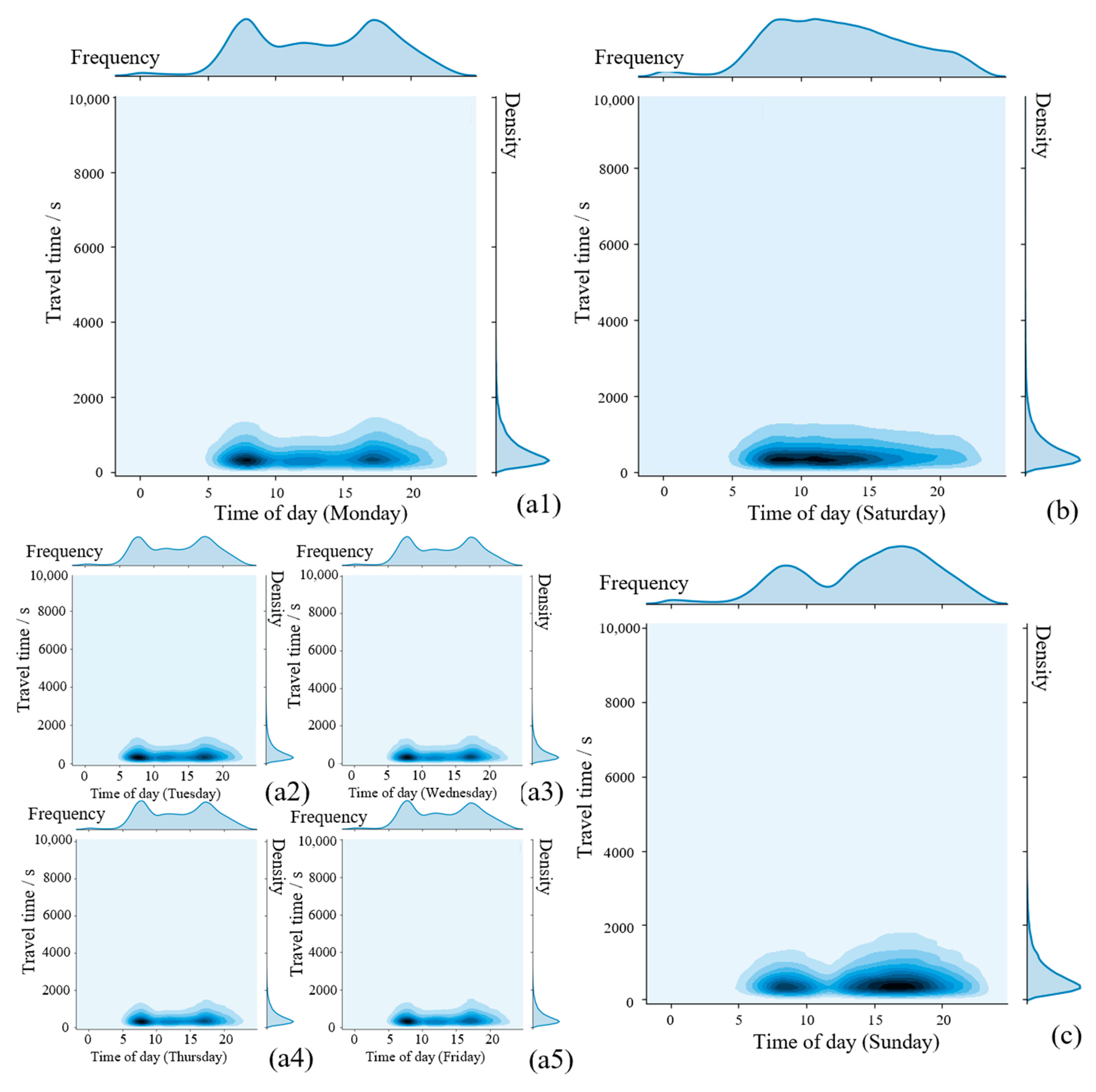
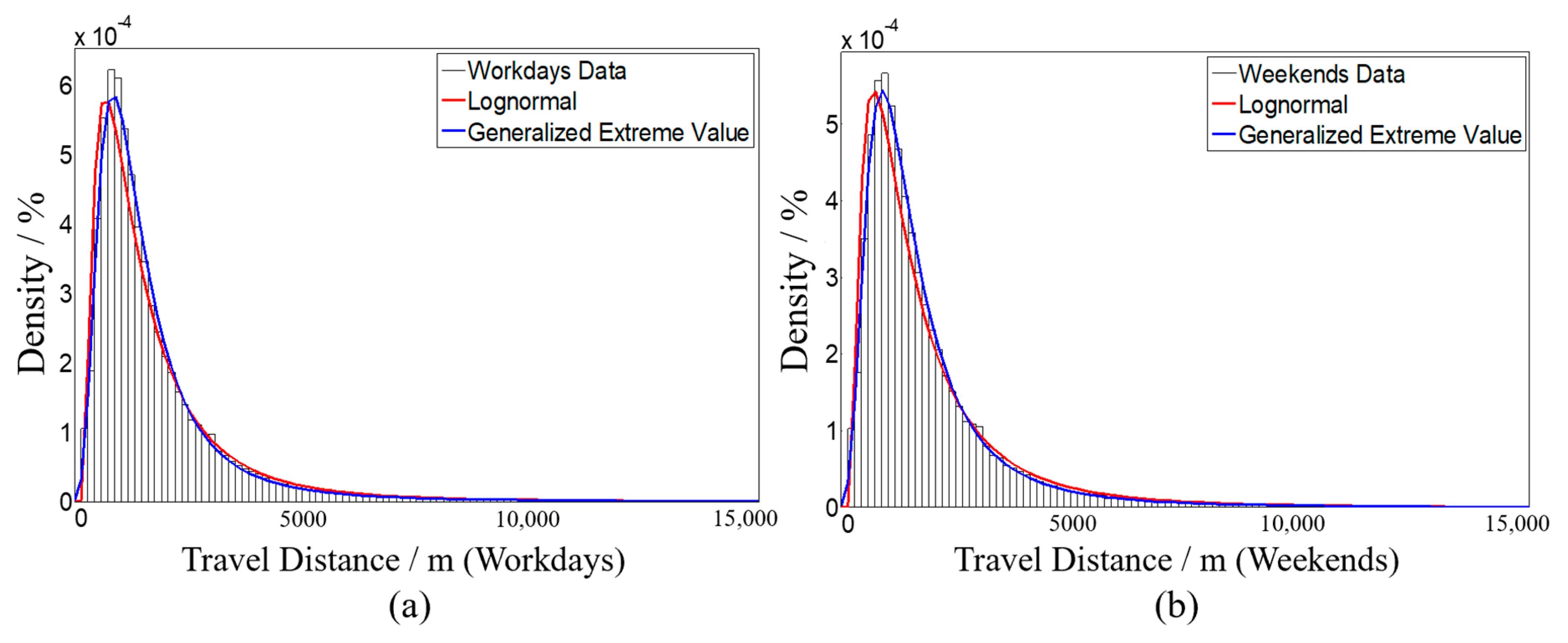
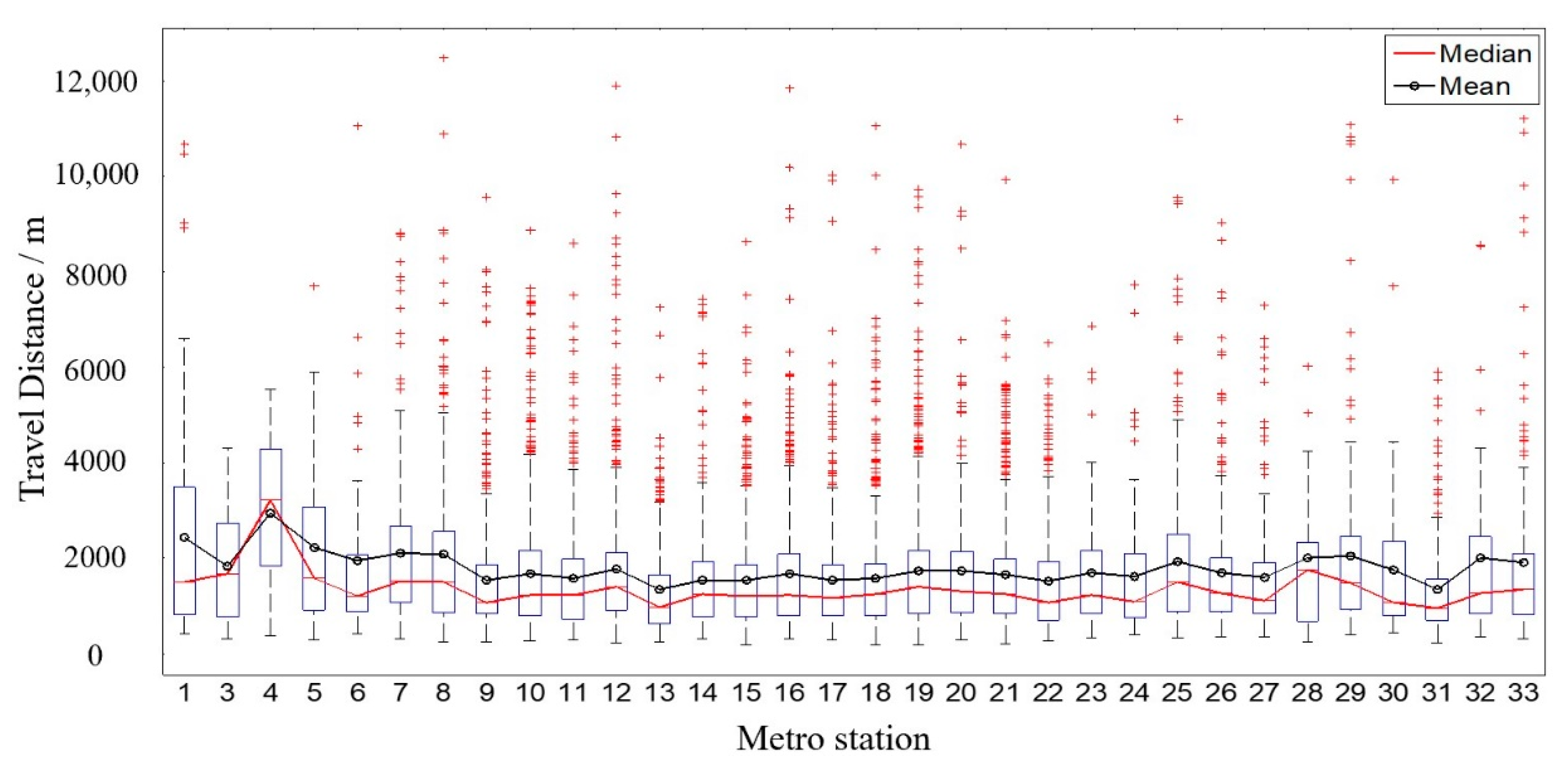
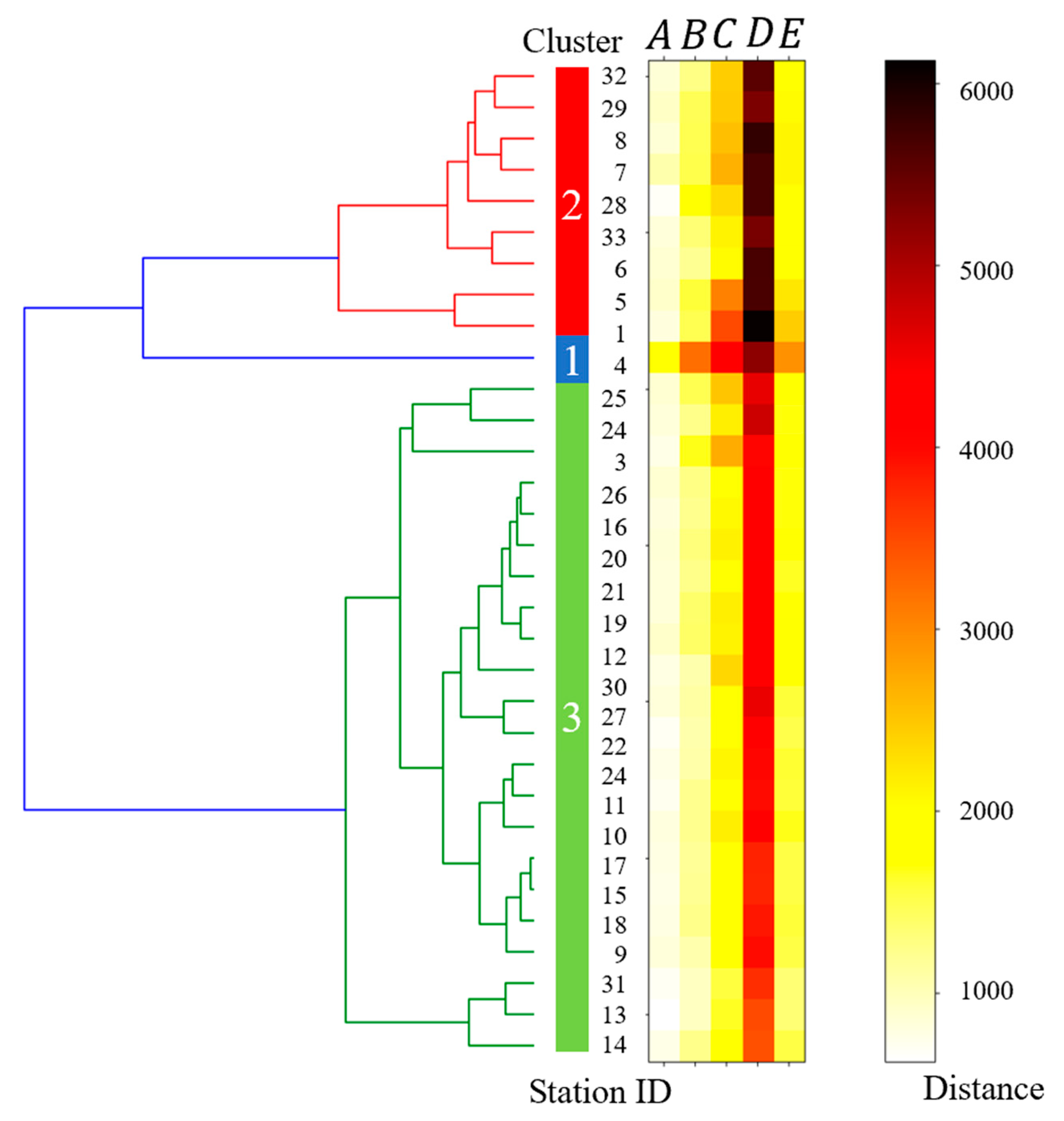
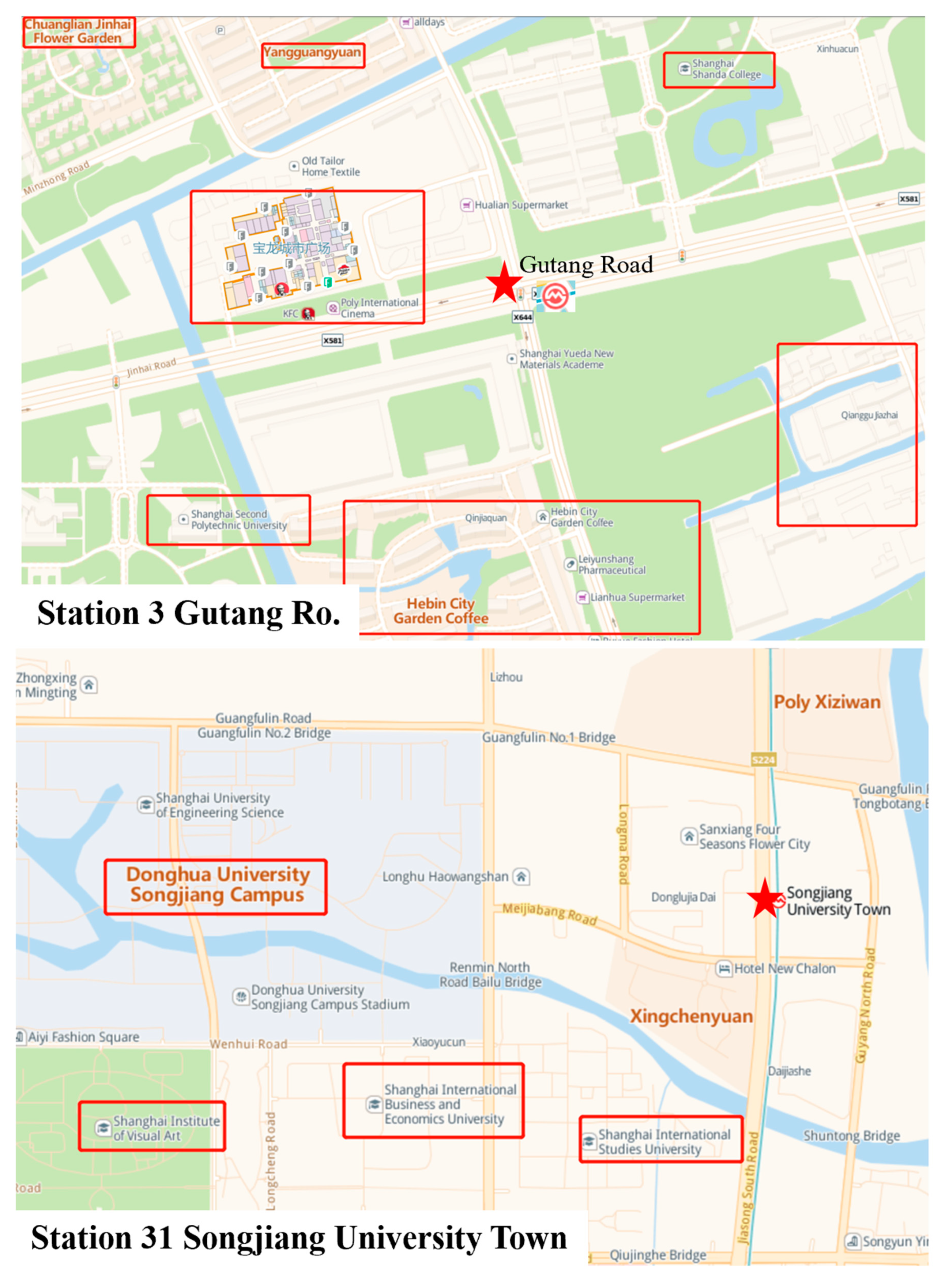
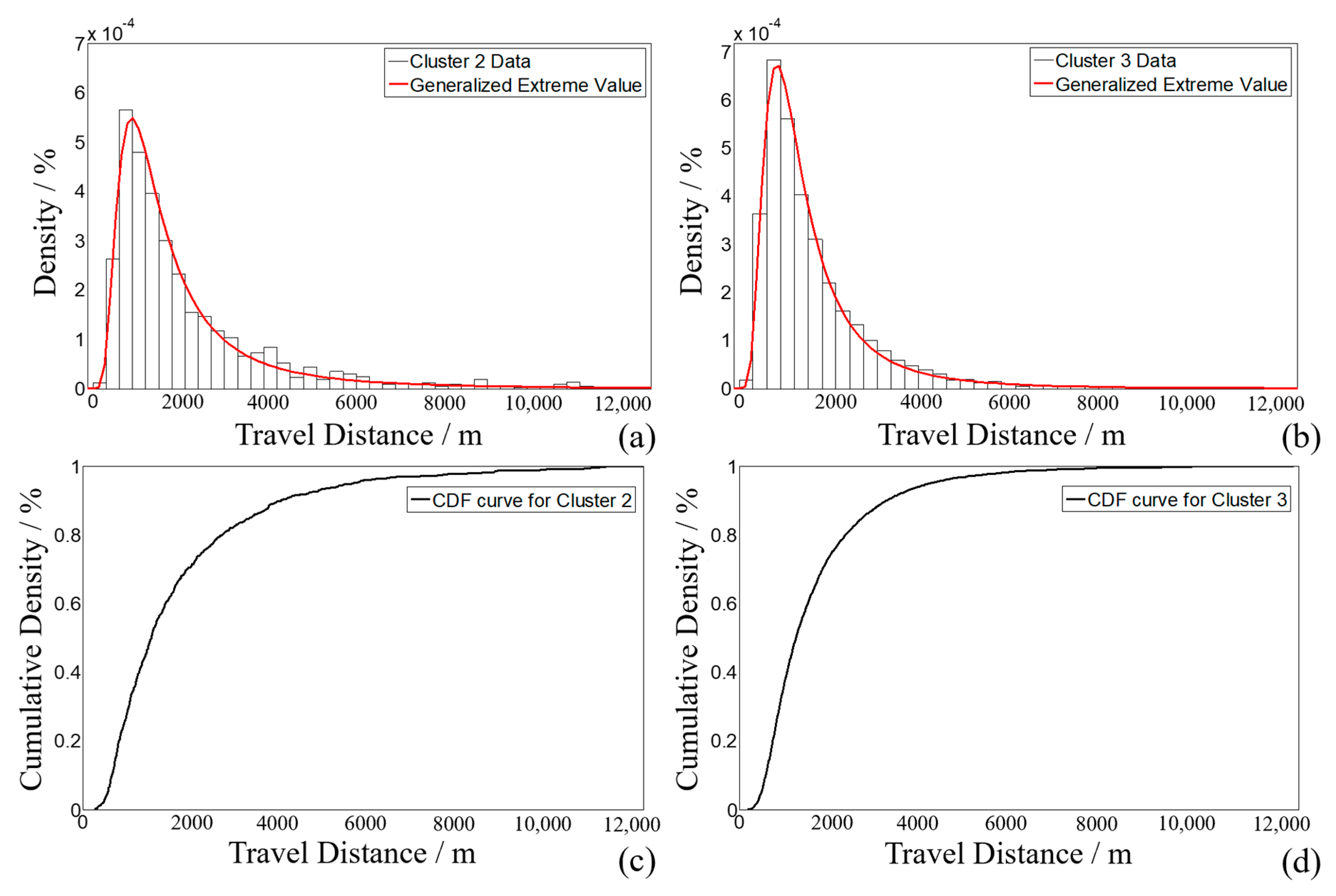
| ID | Name | ID | Name | ID | Name |
|---|---|---|---|---|---|
| 1 | Caolu | 13 | Xiaonanmen | 25 | Qibao |
| 2 | Minlei Ro. | 14 | Lujiabang Ro. | 26 | Zhongchun Ro. |
| 3 | Gutang Ro. | 15 | Madang Ro. | 27 | Jiuting |
| 4 | Jinhai Ro. | 16 | Dapuqiao | 28 | Sijing |
| 5 | Jinji Ro. | 17 | Jiashan Ro. | 29 | Sheshan |
| 6 | Jinqiao | 18 | Zhaojiabang Ro. | 30 | Dongjing |
| 7 | Tai’erzhuang Ro. | 19 | Xujiahui | 31 | Songjiang University Town |
| 8 | Lantian Ro. | 20 | Yishan Ro. | 32 | Songjiang Xincheng |
| 9 | Fangdian Ro. | 21 | Guilin Ro. | 33 | Songjiang Sports Center |
| 10 | Middle Yanggao Ro. | 22 | Caohejing Hi-Tech Park | 34 | Zuibaichi Park |
| 11 | Century Avenue | 23 | Hechuan Ro. | 35 | Songjiang South Railway Statioon |
| 12 | Shangcheng Ro. | 24 | Xingzhong Ro. |
| Bike ID | Start Time | Start Longitude | Start Latitude | Return Time | Return Longitude | Return Latitude | Service Time/s |
|---|---|---|---|---|---|---|---|
| 169·B4 | 2018/08/26 07:45:01 | 121.398772532346 | 31.2595986596458 | 2018/08/26 07:57:48 | 121.386097072529 | 31.2508800507453 | 767 |
© 2020 by the authors. Licensee MDPI, Basel, Switzerland. This article is an open access article distributed under the terms and conditions of the Creative Commons Attribution (CC BY) license (http://creativecommons.org/licenses/by/4.0/).
Share and Cite
Yan, Q.; Gao, K.; Sun, L.; Shao, M. Spatio-Temporal Usage Patterns of Dockless Bike-Sharing Service Linking to a Metro Station: A Case Study in Shanghai, China. Sustainability 2020, 12, 851. https://doi.org/10.3390/su12030851
Yan Q, Gao K, Sun L, Shao M. Spatio-Temporal Usage Patterns of Dockless Bike-Sharing Service Linking to a Metro Station: A Case Study in Shanghai, China. Sustainability. 2020; 12(3):851. https://doi.org/10.3390/su12030851
Chicago/Turabian StyleYan, Qiang, Kun Gao, Lijun Sun, and Minhua Shao. 2020. "Spatio-Temporal Usage Patterns of Dockless Bike-Sharing Service Linking to a Metro Station: A Case Study in Shanghai, China" Sustainability 12, no. 3: 851. https://doi.org/10.3390/su12030851
APA StyleYan, Q., Gao, K., Sun, L., & Shao, M. (2020). Spatio-Temporal Usage Patterns of Dockless Bike-Sharing Service Linking to a Metro Station: A Case Study in Shanghai, China. Sustainability, 12(3), 851. https://doi.org/10.3390/su12030851






